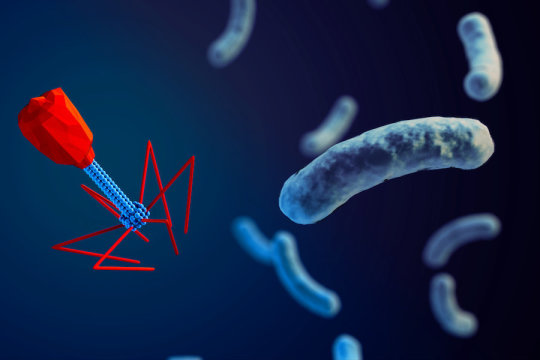For long antibiotics have been using for the treatment of various diseases. However, with the complexity and bacterial resistance antibiotics got failed to function and produce effective results in the patients. With this problem over the ruling, the clinical benches introduced the phage treatment. Yes, you read it right, the phage is now in use for diseases treatment.
In May, a research team from University of Pittsburgh’s Graham Hatfull treated a serious patient of Cystic fibrosis from a mixture of genetically engineered phage. The phage therapeutics functioned in the genetically ill patient and it helped him recover from his disease. These results made a great contribution as it was the first genetically engineered phage treatment given to any patient and it was the very first treatment against any bacteria such as in this case Mycobacterium. It has also shown potential as a therapy against the biggest issue of antibiotic-resistant bacteria, the future of synthetic biology approaches which was long avoided by West.

History
However, if we look back into the history and evolution of phage therapeutics it has expanse in 100 years. In 1919, it was first tested as a prophylactic against Avian hypnosis in France. In Europe and the United States, a cocktail of phages used in the pre-antibiotic era as a source of treatment. In Russia, Central, and Eastern Europe the cocktail of phages is still used to treat Wound infections, Gastroenteritis, Sepsis, and other ailments.
In the West, the use of phages rejected once the antibiotics came into the hold. Later in 1940’s the pioneer work with the bacteriophage T4 as a genetic tool to enter into the central dogma of cell and take hold give a little spark to this field but lack of peer-reviewed published data, political stigmas and predominance of phage work than the pathogenic bacteria which are resistant to these phages resulted in a setback to this field.
In the twenty’s, with the new sequencing techniques introduced in the market, the interest in phage biology greatly increased. It was suggested that the phage genetic engineering and characterization could address various therapeutic issues like product consistency, poor tissue distribution, pharmacodynamics and immunogenicity issues.
Despite the uncertainties and skepticism of old pharma traders in mid-twenties, many companies came forward with phage therapeutics such as Biophage Pharma, Enzobiotics, Exponential Biotherapies, GangaGen, Hexal Gentech, Intralytix, MicroStealth Technologies, Phage Biotech, Phage Therapeutic, PhageGen, etc. However poor funding resulted in the closure of a number of these companies. Today only GangaGen in India, Intralytix in Bourn, UK-based Phico Therapeutics and Phage Biotech of Israel are in business. Intralytix and Phage Biotech survived by deploying phage in agriculture to control plant diseases detect pathogens and assess food safety.
Current trends
After the news of successful treatment of Cystic fibrosis last year, the University of California established the Phage Translational Research Centre. A three year $1.2 million grant is announced by the UCSD chancellor for the center. It is said that the same clinical evaluation and development principles will be applied to phage therapy as applied to any other therapeutic system.
1n 2010, A&M University in Texas developed the Centre of Phage Technology (CPT) to focus on animal husbandry and agriculture avoiding human involvement. Later with the help of advanced technologies of phage-host interaction and characterization studies and re-evaluation of phage therapy, the CPT is overloaded with the requests of using phage treatments for the Multiple Drug Resistance (MDR) patients.
Tom Patterson, a UCSD professor caught MDR infection on his visit to Egypt. He was just dying with organ failure when his wife came across phage treatment and saved his life. He treated through a catheter into the abdomen and intravenously. He made a comeback from a coma and within three months he fully got cured of the infection.
Apart from such treatment, phages can use as precision medicines target specific pathogens and spare the healthy bacteria of the body. They can also use in combination with antibiotics. It was observed that some bacteria that earlier left from phage treatment grow sensitive and killed after the dosage of antibiotics.
Testing strategies
Two strategies usually apply to test phage treatment by the companies producing them, which basically based on phage combinations and bacterial diversity.
- The first strategy is the limited combination of phages in a cocktail for low diverse bacterial treatment. Such therapy can be pulled out of the refrigerator and used just like any other therapeutic.
- The second testing strategy is for those patients whose bacteria are more diverse. In this case, the infectious entity is continuously monitored for resistance. So that if a phage or a cocktail of phages failed to function at any point it can replace quickly with another phage attacking any other receptor.
Paul Grint, a company’s CEO worked on the first strategy to produce a phage therapeutic on his development analysis and unveiled that phages cause the production of enzymes that break the bacterial biofilm which protect the pathogens from antibiotics and give them resistance. Once exposed antibiotics become potent on them. “It’s not about phages or antibiotics; it’s about phages and antibiotics.” Said Grint.
Conclusion
In short, phage therapy will revolutionize clinical treatment. Though it is a time consuming and expensive approach companies are trying to scale up production and deliver products under Good Manufacturing Practices quickly and reliably due to its potent therapeutics. But will they stand up to expectations? And will the genetic engineering will stay within the ethical grounds. Schooley said, “Phages are viruses and they will do what they want to do and not necessarily what we want them to, So ultimately when phage are widely used—and I think they will be—it has to be on firm scientific footing.”

Rida Nayyab is a young activist and a Cricket freak. She is a Student of Bio-Chemistry and striving for a better future. Rida is also a freelance writer, social enthusiast, and love to reading, writing and exploring. She is head of the social media team of Scientia magazine.

